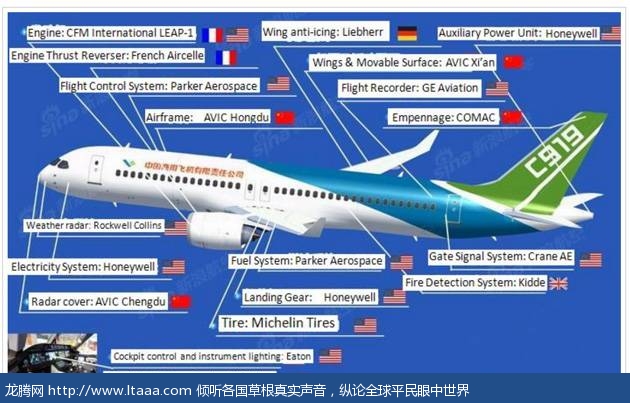中国的国产大飞机是某种飞翔的Iphone吗? [美国媒体]
本周早些时候,中国商飞(简称COMAC)推出了为之工作多年的新C919客机。我当时写下了这款飞机的诞生对于中国的航空产业抱负来说无疑是极具意义的一步,值得为之骄傲。但是我同时也试图解释,为什么担心这即将为波音和空客敲响丧钟......是不必要的担心,或者说至少是言之过早。
Is the New Chinese Airliner a Kind of Flying iPhone?
中国新的大飞机,是某种飞翔的Iphone吗?
James Fallows(作者)
Illustration from Sina aviation news service of suppliers for China’s new C919 airliner.
新浪航空新闻提供的插图:中国C919客机的供应商。
译注:图片介绍
1.该图一共列出19个部件的供应商。
2.中国国旗一共四面,全部是各类机壳。
3.美国国旗一共11面,多为精密器件和系统。
Earlier this week China’s state commercial-aerospace company, known as COMAC, rolled out the new C919 airliner it has been working on for years. I noted at the time that the plane’s debut was of course a significant step in China’s aerospace ambitions, and a deserved source of pride. But I also tried to explain why concerns that this meant imminent doom for Boeing and Airbus, as with a recent Seattle Times headline that “China Targets Puget Sound With New Plane,” were over-wrought, or a least tentative and many years premature.
本周早些时候,中国商飞(简称COMAC)推出了为之工作多年的新C919客机。我当时写下了这款飞机的诞生对于中国的航空产业抱负来说无疑是极具意义的一步,值得为之骄傲。但是我同时也试图解释,为什么担心这即将为波音和空客敲响丧钟——比如最近西雅图时报一个头条新闻说“中国新飞机目标皮吉特湾(G19注:波音老家)”——是不必要的担心,或者说至少是言之过早。
The long version of why that’s so is what I laid out in my book China Airborne, which was a study of the larger problems the Chinese economy may have in shifting toward “rich country” industries like aerospace. (And which, I have to say, has stood up pretty well in the 3 years since its appearance.) The shorter way to get the idea is to take a look at the illustration above.
为什么如此,我在我的“China Airborne”这本书里有详细记述,该书研究中国经济在向“富裕国家”产业比如航空业转型过程中的主要问题(我必须要指出,这本书出版3年来,现实是颇为应验)。了解这些问题的一个简单的方法,就是看看这张插图。
It’s originally from the Chinese news service Sina, and it’s a couple of years old, so details may have changed. But its main message is that all the most valuable and complex components in the C919 come from somewhere else.
这张图来自中国新闻网站新浪,有些年头了,所以细节可能有变化。但是它提供的主要信息是,C919所有最有价值的和复杂的零件都不是中国产的。
The engines are from the US-French consortium CFM. Most of the electronics are from U.S. or European firms. I haven’t seen a detailed costing-out of the entire value of the airplane, and probably it’s confidential. But beyond doubt most of the value of the plane lies in imported components brought to China for assembly.
引擎来自美法合资的CFM。大部分电子元件来自美国或欧洲公司。我没有关于飞机整体价值的详细的成本核算表,这可能是保密的;但无疑这款飞机的大部分价值依赖于进口原件,只是在中国组装。
This is why I said in my book that the C919 could be thought of as a huge flying counterpart to the iPhone. Each of them is “made” in China; each has most of its technology and value coming from somewhere else.
这就是为什么我在我的书中说你可以把C919想象成一个巨大的可以飞行的Iphone,它是中国造的,但其技术和价值所在并非来自中国。
You can see different corporate and national dynamics playing out here. On China’s side, the (rational) belief that the best way to get into the high-value industries is to begin by assembling them. On the U.S. and European side, the (indisputable) awareness that the Chinese government will require them to do work within China to get Chinese markets, and the (hopeful, and consequential) belief that they can keep out-innovating Chinese competitors fast enough to maintain a lead. Of course a lot of corporate and national economic welfare turns on the validity of this last belief.
你可以看到各种公司和国家的因素在这里发生作用。对中国来说这是一合理的信念,即切入这个高价值的产业的最好方法就是从组装工作开始。对于美国和欧洲公司来说,当然知道如果想获得中国市场,不容争辩,中国政府肯定会要求他们把一些工作放在中国国内;他们所持的信念是相信自己可以保持对中国竞争对手的创新优势,行动更快,保持领先。当然,许多公司和国家的经济红利将取决于后面这种信念是否成立。(G19注:意为,谁是更大的获利者,是中国还是欧美公司,取决于欧美公司是否能保持住创新优势)
版权声明
我们致力于传递世界各地老百姓最真实、最直接、最详尽的对中国的看法
【版权与免责声明】如发现内容存在版权问题,烦请提供相关信息发邮件,
我们将及时沟通与处理。本站内容除非来源注明五毛网,否则均为网友转载,涉及言论、版权与本站无关。
本文仅代表作者观点,不代表本站立场。
本文来自网络,如有侵权及时联系本网站。
图文文章RECOMMEND
热门文章HOT NEWS
-
1
Why do most people who have a positive view of China have been to ...
- 2
- 3
- 4
- 5
- 6
- 7
- 8
- 9
- 10
推荐文章HOT NEWS
-
1
Why do most people who have a positive view of China have been to ...
- 2
- 3
- 4
- 5
- 6
- 7
- 8
- 9
- 10











